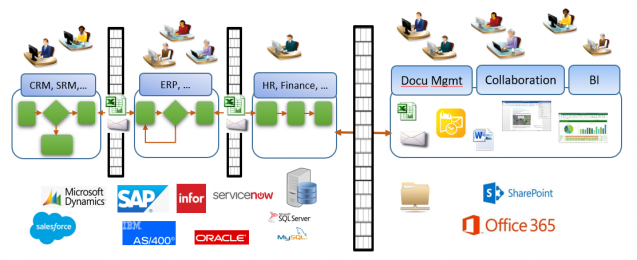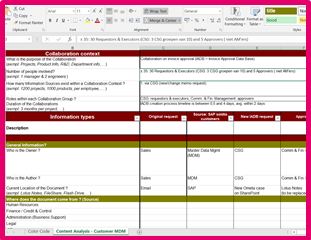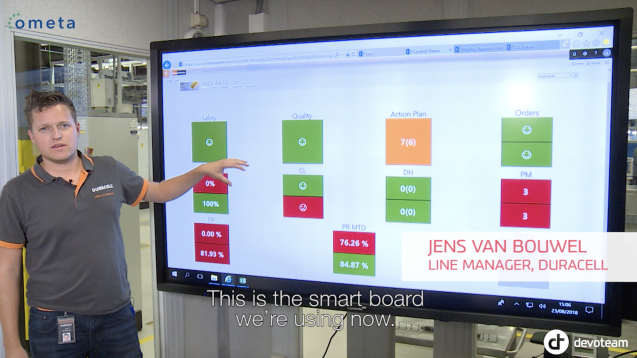Today, most large organisations that are setting up a fully Digital Workplace are stuck and therefore they’re a bit unhappy. Although they have integrated most of their traditional information silo’s, they still are working with two or three isolated systems. This results in paperwork, copying data and exchanging information via manually maintained Excel sheets. That sort of situation doesn’t look at all as a Digital Workplace indeed. We guess it’s time for a new approach. If this sounds familiar, please read on, because we believe that we have a solution and also the best way to deal with it.
So, let’s first define in more detail what we’re talking about. Most large organisations run an ERP, CRM and Finance environment (such as SAP), a document management environment (such as Microsoft Office) and a Manufacturing Execution System if they happen to be an industrial company. The Digital Workplace concept implies that data will flow easily and automatically between those environments, but you know as well as I do that in most large organisations it passes from one environment to the other via Excel sheets, or, worse, via handwritten reports.

All this means that the internal, single Digital Workplace is not yet fully functioning. But there’s more to solve, because a fully automated information integration with suppliers and large customers is an even more distant dream. True, most of what’s ERP related runs around digitally without any human intervention, but the moment you start adding traditional Word and Excel documents, the so-called unstructured data, or want to collaborate digitally with external parties, it’s back to email and phone calls.
Even in organisations where paper has disappeared and all documents are digital, those documents are often still on company file shares or hopefully on a document management and collaboration platform such as Microsoft SharePoint. Only rarely they are ready to be used intuitively, easily findable and integrated in enterprise applications within their business contexts.
Bring down the final barriers
So this is why we need a new approach, the last information barriers have to disappear together with all paperwork. What we imagine is a productive Digital Workplace where all islands are integrated into one, with collaboration workers connected in real-time, using one interface where they find the right data, information and documents at the right time and in the right business context. And where information is pushed to them when it’s necessary and appropriate.

Or in other words, intelligent information management requires that data (think ERP systems) and content (think Word or Excel documents) are integrated. A full Digital Workplace requires competencies and technologies from both the data management and content management worlds. Some pronounce that Enterprise Content Management is dead and maybe Enterprise Resource Planning is dead too. We’d rather let them live, fully integrated, of course.
You don’t need this integrated Digital Workplace only to tell everyone with a big smile that you have one. You need it because it allows you to put your customer at the centre of all your operations. Only when all information is automatically and immediately flowing around, you can offer a tremendous customer service. Or, when you’re an industrial company, replace your mass production with ever more customisation based on real-time market demand.
To get there, we only need two things: a software and a very efficient method to use it.
Step one: great software
The software is Ometa, it’s one of the few products that can integrate information flows over any type of platform, such as ERP, CRM, MES/MOM and warehouse systems and Microsoft Office. What makes Ometa unique is all the different connections they can make out of the box and the affordable price at which this comes.

We’re halfway already. The potential for productivity gains, high quality data, better managed risk and compliancy, is almost unlimited. Think of one user-friendly web portal where information workers can access line of business data without having to switch to their ERP systems. A web portal where dashboards can present a mash-up of data from different line of business systems, in real-time, with all necessary security and access rights applied.
Next to web portals to read and write ERP data, you can also run your case management where the structured processes of line of business applications are integrated with unstructured content from traditional documents. Information workers can work on cases where all documents, emails, scans and photos related to a certain case are stored and connected with their structured data for further treatment. This is possible for employee records, legal dossiers, complex price quotations, support cases managed in collaboration with partners, projects, orders, etc.
The Ometa software goes further than facilitating information flows to users on web portals. Based on modern web technologies and built-in support for industry standards such as OData, it also acts as a best-in-class middleware to orchestrate information flows between different line of business applications. That can be either inside your organization or together with systems of your customers or suppliers. It’s a key building block for the realization of digital transformation and automation strategies in smart factories, smart cities, digital government, etc.
All information flows are centralised in Microsoft SharePoint for swift collaboration. With SharePoint as a portal, it’s also easy to present your information on any device (pc, tablet, smartphone). Its out-of-the-box sharing capabilities make secure communication of information with customers, partners and suppliers a reality in no time. You can opt for an on-premises deployment, a hybrid deployment with components in the cloud or a full cloud solution running on Microsoft Office 365 and Microsoft Azure.
Step two: painless analysis
But that’s just the software. To make it do what you want it to do, you need the right approach. Let’s start by telling you what we will not do. We will not analyse your business processes again. You’ve done it before and you’re probably tired of it.
 Content analysis
Content analysis
Because we need to integrate your information, we will only look at your documents. It’s not even an analysis of those documents, we will just list them. This is probably the easiest preparation for an IT project that you’ve ever experienced. You only need to answer question such as: what do you put in Excel sheets, where does that information come from, where does it go to, what paper reports do you use, what information do you manually copy from one system to another, what pdf’s do you send around via email, what do you put on display, etc. Obviously, this process can become a bit hard anyway, because it can take quite a while before the whole list is ready.
Focus on information flows, not business processes
When the list is ready, we will look for the quick wins. Most likely it will be getting rid of complex Excel sheets, paper reports or handwritten information on whiteboards and other displays. It’s surely not a surprise that a Digital Workplace cannot run well as long as some handwritten information prevails. For each quick win, we will build a business case, though. We will most likely reduce costs for communication and travel, lower facility expenses by enabling home and flex working, limit licensing costs, maybe eliminate some software maintenance contracts and reduce overall operational management costs.
There are more ROIs to be achieved with a true Digital Workplace, although some are not always so easy to measure, such as improved user productivity, streamlined workgroup processes, time gains thanks to a consistent user interface, living up to the consumerized IT expectations of younger staff, managing risk centrally and better avoiding exposures to information leakage.
Industrial companies can expect a higher flexibility in their supply chain, shorter throughput times, fewer errors of goods coming in, zero errors in their master data, better tracking and tracing, a fully connected shop floor, lowered maintenance costs, a very effective search for quality issues and finally a paperless process from product development to customer service.
Because we go for no less: an integrated environment and a single information flow from product development, engineering, procurement, production, sales, logistics and finance right up to customer service, with governance and compliance included. That’s what we call a Digital Workplace.

 Digital Workplace @ Duracell’s shop floor
Digital Workplace @ Duracell’s shop floor